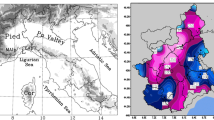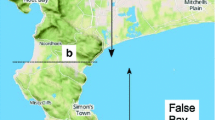Abstract
The windstorm VIVIAN that severely affected Switzerland in February 1990 has been investigated using the Canadian Regional Climate Model (CRCM). This winter storm was characterised by a deep cyclone in the North Atlantic and by strong geopotential and baroclinic north-south gradients in the troposphere over Western Europe resulting in high windspeeds in Switzerland. Our principal emphasis is to demonstrate the ability of the CRCM to simulate the windfield intensity and patterns. In order to simulate winds at very high resolution we operate an optimal multiple self-nesting with the CRCM in order to increase the horizontal and vertical resolution. The simulation starts with downscaling NCEP-NCAR reanalyses at 60 km with 20 vertical levels, followed by an intermediate 5-km simulation with 30 vertical levels nested in the former. The 5-km output is in a final phase used for initial and lateral conditions for a 1-km resolution simulation with 46 vertical levels. The multiple self-nesting in the horizontal is necessary to reach sufficient resolution to better capture the orographic forcing that modulates the atmospheric circulation at fine scales, whereas the vertical resolution enhancement helps to better simulate the boundary layer that modulates the windspeed along the surface and better represents the atmospheric circulation with a complex vertical structure (low-level jets, gravity waves and frontal features). It has also been found that the simulated temporal variability of the windfield and of most variables at the finer scales increases with the increasing nesting frequency. This indicates that as we progress towards finer scales in the horizontal, the vertical and the nesting frequency enhancement helps to simulate windspeed variability. However, the variability within the larger domain is limited by the archival frequency of reanalysis data that cannot resolve disturbances with time scale shorter than 12 h. Results show that while the model simulates well the synoptic-scale flow at 60-km resolution, cascade self-nesting is necessary to capture fine-scale features of the topography that modulate the flow that generate localised wind enhancement over Switzerland.
Similar content being viewed by others
Author information
Authors and Affiliations
Additional information
Received: 6 July 2000 / Accepted: 13 February 2001
Rights and permissions
About this article
Cite this article
Goyette, S., Beniston, M., Caya, D. et al. Numerical investigation of an extreme storm with the Canadian Regional Climate Model: the case study of windstorm VIVIAN, Switzerland, February 27, 1990. Climate Dynamics 18, 145–168 (2001). https://doi.org/10.1007/s003820100166
Issue Date:
DOI: https://doi.org/10.1007/s003820100166




